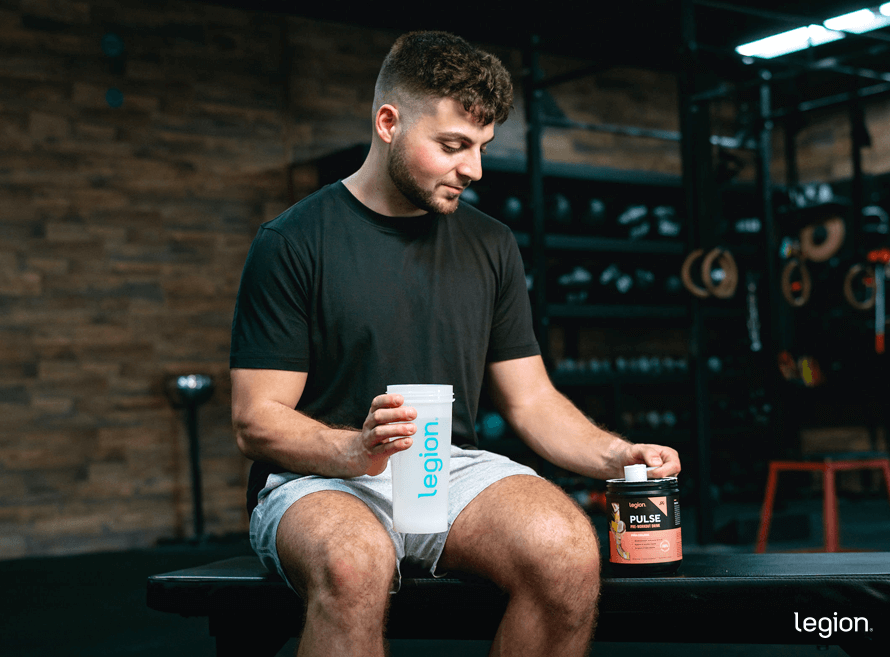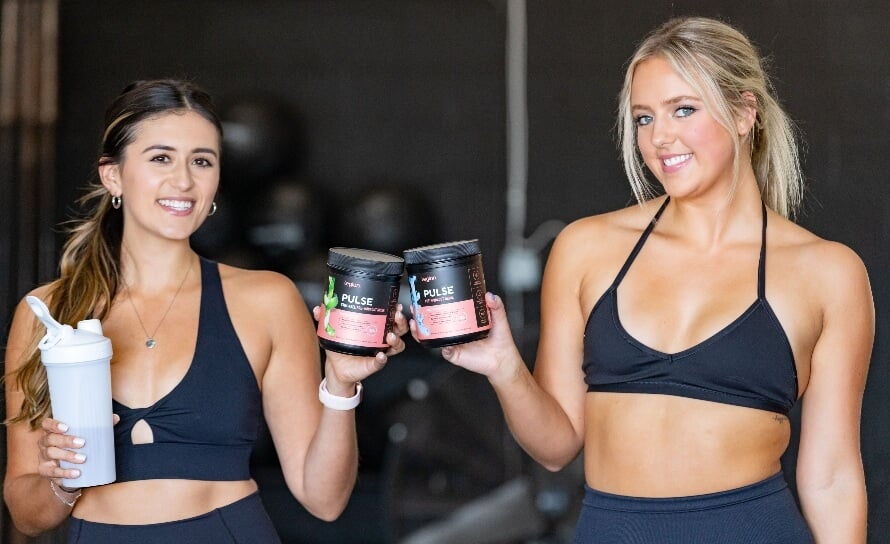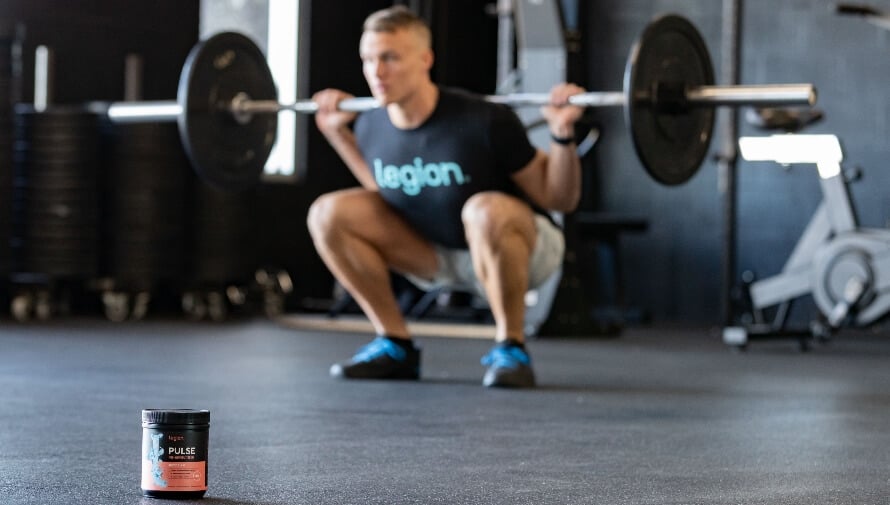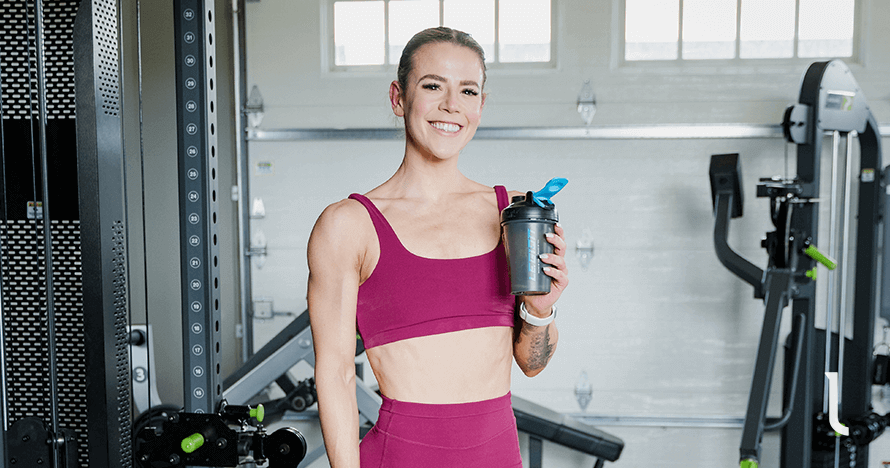
“Does pre-workout cause acne?”
This is a common question among fitness enthusiasts wondering whether their pre-workout supplement is behind their breakouts.
According to some “experts,” the answer is a resounding yes.
In their opinion, pre-workouts contain “toxic” ingredients that disrupt your hormones, upset your skin and gut microbiota, cause oil and sweat buildups, and more, all of which can cause acne.
But how accurate are these claims?
Can pre-workouts give you acne?
Get an evidence-based answer in this article.
Key Takeaways
- Pre-workout doesn’t cause acne, and there’s no solid evidence it worsens breakouts in people prone to acne.
- Many people blame ingredients like creatine, caffeine, and vitamin B12 in pre-workout for causing acne, but research doesn’t support this claim.
- Taking artificially sweetened pre-workouts or drinking pre-workout protein shakes with dairy (like whey or casein) may contribute to acne for some, but their effects depend on the individual.
- Intense workouts can temporarily increase your testosterone levels, which might affect your skin’s oil production, but the effect is minimal and unlikely to cause acne.
- If you’re worried about breakouts, look for a pre-workout without artificial sweeteners or dairy (like Pulse), and consult a dermatologist for personalized advice about the best skincare routine for you.
Does Pre-Workout Cause Acne?

Let’s get one thing straight: pre-workout doesn’t cause acne.
There’s also no evidence pre-workout makes acne worse in those prone to pimples.
Nevertheless, blogs and online message boards are full of anecdotes about how pre-workout can give you acne.
Let’s explore why this might be.
Why People Believe Pre-Workout Can Cause Acne

While many people associate the ingredients in pre-workout supplements with acne breakouts, there’s no proof pre-workout causes acne.
Let’s examine the compounds in question more closely, and explore why they’re probably not to blame for pimples.
1. Creatine
Creatine is a natural compound often included in pre-workout for its performance- and recovery-boosting effects.
Many people also believe creatine increases testosterone.
Three studies form the basis of this stance: two that found people who took creatine saw their testosterone levels rise, and one that found athletes who took creatine experienced an increase in dihydrotestosterone, a hormone converted from testosterone.
This matters because testosterone increases the production of sebum (an oily substance produced by your skin’s sebaceous glands), which can aggravate the sebaceous glands and cause an acne flareup.
The problem with this argument is that the few studies showing a link between creatine and increased “T” are outliers—most research shows that creatine has no effect on testosterone..
In other words, creatine doesn’t increase testosterone and, thus, probably doesn’t increase your risk of acne.
2. Vitamin B12
Vitamin B12 plays a role in energy production, which is why supplement companies often include it in pre-workout products.
While older research uncovered an association between B12 and acne, scientists are yet to fully understand the link. Some recent research suggests it could be because consuming high levels of B12 alters the skin microbiota (the bacteria, fungi, and viruses that live on the skin), prompting acne breakouts.
That said, this research also shows that this mechanism doesn’t cause acne in everyone. Moreover, the authors are employees of a company developing an acne treatment, which may color their interpretation of the data.
In other words, the evidence connecting B12 to acne is weak. Until we have stronger evidence from a disinterested third party, it’s probably safe to assume that B12 doesn’t lead to acne.
3. Caffeine
Caffeine is perhaps the most common pre-workout ingredient because it enhances athletic performance in numerous ways.
It also increases cortisol (the “stress hormone”), which is relevant because stress and acne often go hand in hand.
Crucially, this is only an association—no research shows that caffeine causes or exacerbates acne.
Another theory suggests that caffeine increases sweating, which some believe might aggravate acne.
While little research has investigated this belief, the available evidence suggests it probably isn’t true.
4. Artificial Sweeteners
Many supplement manufacturers use artificial sweeteners in pre-workouts to make their products tasty while remaining low in calories.
This is a concern for those susceptible to acne because research suggests artificial sweeteners may contribute to insulin resistance and disrupt the gut microbiome, both factors that can raise the risk of acne.
While there’s no direct evidence showing artificial sweeteners cause acne, finding a naturally sweetened pre-workout is a simple and potentially effective way to reduce your risk.
5. Dairy
While technically not a pre-workout supplement, some gymgoers like to drink a casein or whey protein shake before they train.
The dairy in these drinks increases levels of the hormone insulin-like growth factor-1 (IGF-1), which leads to a process called sebaceous lipogenesis.
During sebaceous lipogenesis, the skin’s sebaceous glands produce oils to keep the skin moisturized. When it produces too much natural oil, acne can develop.
However, the evidence linking dairy to acne is inconsistent. Several case reports and observational studies have found an association, but others haven’t.
So, although there might be a relationship between dairy consumption and acne, it’s not yet clear how strong or direct that connection is, and we can’t definitively say dairy causes acne.
6. Hormones
Pre-workout supplements don’t contain hormones, but they increase your energy levels, allowing you to train more intensely.
After intense workouts, testosterone levels rise for a short period. As we’ve already seen, this can make the skin produce more oil, which, when mixed with dead skin cells, can clog pores and contribute to acne formation.
Importantly, the rise in testosterone is minor and short lived. It’s also not particularly pronounced if you’re new to training, female, doing mainly isolation (single-joint) or machine exercises, obese, or older.
In other words, pre-workout may help you train harder, which may increase your T to a small degree, but it’s unlikely to meaningfully worsen acne, especially if you have a sensible skincare routine that optimizes overall skin health (more on this soon).
7. Beta-Alanine
Beta-alanine is an amino acid often included in pre-workout formulas because it helps boost endurance and reduce fatigue.
The only downside is that it also commonly causes an itching or tingling sensation, usually in the face, neck, and hands, around 15 minutes after you take it. Technically, this sensation is called paresthesia, though people usually refer to it as “beta-alanine itch.”
While this itch is completely harmless, many believe it’s triggered by an allergic reaction that may also contribute to acne breakouts.
This is a misunderstanding. The itch occurs because beta-alanine binds to a nerve receptor called Mas-related G protein-coupled receptor D (MrgprD), a process that’s “histamine-independent,” which means it doesn’t involve your immune system at all.
In other words, your pre-workout isn’t irritating your skin or causing acne—it’s simply activating nerves that make your skin feel tingly. To learn more about why beta-alanine causes this sensation, check out this article:
Why Does Pre-Workout Make You Itch? Beta-Alanine Explained
8. Steroids
Steroids aren’t an ingredient in pre-workout supplements, but they’re worth mentioning in this context.
Reason being that the most jacked fitness enthusiasts who also have acne may say their pre-workout causes their acne to cover up their steroid use.
Steroids significantly affect the body’s hormonal balance, leading to an increase in sebum production and, subsequently, acne. Unlike the minor and temporary increase in testosterone from intense workouts, steroids can cause a substantial and sustained hormonal imbalance.
This makes the skin more prone to acne flare ups than any ingredient in pre-workout supplements. So, when you hear someone saying their pre-workout gives them acne, consider that steroids might be the real reason for their pimples.
3 Tips to Avoid Acne if You Take Pre-Workout

Does pre-workout give you pimples?
Probably not.
Nevertheless, to minimize your chances of getting acne while taking pre-workout, here are three evidence-based tips:
1. Avoid pre-workouts containing artificial sweeteners.
Artificial sweeteners may increase your risk of suffering from acne by affecting insulin sensitivity and disrupting your gut microbiome. Opting for naturally sweetened pre-workout supplements can help avoid these issues, making it a simple yet effective change.
For a naturally sweetened and flavored pre-workout that contains no artificial food dyes, fillers, or other unnecessary junk, try Pulse with or without caffeine.
2. Use a plant-based protein powder.
If you drink a protein shake before your workouts, consider switching to a plant-based option.
Dairy products can increase levels of certain hormones linked to sebum production and acne. Plant-based proteins, on the other hand, are less likely to affect your hormone levels in the same way, possibly reducing the chance of breakouts.
For a natural plant-based protein powder with a premium blend of rice and pea protein and no animal-derived ingredients or added sugars, try Plant+.
3. Consult a dermatologist about the best skincare routine for you.
Everyone’s skin is different, and what works for one person may not work for another. A dermatologist can provide personalized advice on skincare products and routines that can help keep your skin clear.
This might include recommendations on cleansers, moisturizers, and any topical treatments that could be beneficial for your skin type and symptoms.
The Bottom Line on Whether Pre-Workout Causes Acne
There’s no solid evidence that pre-workout supplements cause acne. The ingredients people usually blame—like creatine, caffeine, beta-alanine, and vitamin B12—don’t affect your hormones or skin in ways that trigger breakouts.
That said, artificial sweeteners and dairy may play a role for some people, though we need more research before we can say how they influence your risk of acne.
If you’re prone to acne, focus on maintaining a consistent skincare routine and choosing a naturally sweetened, dairy-free pre-workout. For a formula that checks both boxes and contains clinically effective doses of six ingredients shown to boost energy, focus, strength, and stamina, try Pulse.
Does Pre-Workout Cause Acne: FAQs
FAQ #1: Does pre-workout make you break out?
While the idea that pre-workout causes acne is widespread, there’s little scientific evidence to support this claim.
Some ingredients in pre-workouts, such as artificial sweeteners or dairy (in pre-workout protein shakes), may contribute to skin issues for some people, but this varies from person to person.
FAQ #2: Does pre-workout affect your skin?
Pre-workout is unlikely to have a direct impact on your skin’s health. However, some ingredients found in pre-workout supplements could potentially influence your skin, albeit indirectly.
For instance, ingredients that affect your hormones or insulin sensitivity, like dairy protein powders or artificial sweeteners, might contribute to skin issues for some individuals.
FAQ #3: What pre-workout does not cause acne?
To minimize your chances of experiencing acne while using a pre-workout, find a product that contains no caffeine, dairy, or artificial flavors or sweeteners, such as Stim-free Pulse.
To learn more about why a stim-free pre-workout might be a good option for you, check out this article:
How to Choose the Best Stim-Free Pre-Workout Supplement
Want More Content Like This?
Check out these articles:
- Can You Mix Creatine With Pre-Workout for Better Gains?
- Pre-Workout vs. Energy Drink: Which Is Best for You?
- How Long Does Pre-Workout Take to Kick In?
Scientific References +
- Arazi, H., et al. “Effects of Short Term Creatine Supplementation and Resistance Exercises on Resting Hormonal and Cardiovascular Responses.” Science & Sports, vol. 30, no. 2, Apr. 2015, pp. 105–109, https://doi.org/10.1016/j.scispo.2014.03.006. Accessed 28 Feb. 2019.
- Sheikholeslami Vatani, D., et al. “The Effects of Creatine Supplementation on Performance and Hormonal Response in Amateur Swimmers.” Science & Sports, vol. 26, no. 5, Nov. 2011, pp. 272–277, https://doi.org/10.1016/j.scispo.2011.07.003. Accessed 3 Apr. 2019.
- van der Merwe, Johann, et al. “Three Weeks of Creatine Monohydrate Supplementation Affects Dihydrotestosterone to Testosterone Ratio in College-Aged Rugby Players.” Clinical Journal of Sport Medicine, vol. 19, no. 5, Sept. 2009, pp. 399–404, https://doi.org/10.1097/jsm.0b013e3181b8b52f.
- Cook, Christian J, et al. “Skill Execution and Sleep Deprivation: Effects of Acute Caffeine or Creatine Supplementation - a Randomized Placebo-Controlled Trial.” Journal of the International Society of Sports Nutrition, vol. 8, no. 1, 16 Feb. 2011, https://doi.org/10.1186/1550-2783-8-2.
- Crowe, Melissa J., et al. “The Effects of ß-Hydroxy-ß-Methylbutyrate (HMB) and HMB/Creatine Supplementation on Indices of Health in Highly Trained Athletes.” International Journal of Sport Nutrition and Exercise Metabolism, vol. 13, no. 2, June 2003, pp. 184–197, https://doi.org/10.1123/ijsnem.13.2.184. Accessed 19 Aug. 2019.
- Hoffman, Jay, et al. “Effect of Creatine and ß-Alanine Supplementation on Performance and Endocrine Responses in Strength/Power Athletes.” International Journal of Sport Nutrition and Exercise Metabolism, vol. 16, no. 4, Aug. 2006, pp. 430–446, https://doi.org/10.1123/ijsnem.16.4.430.
- OP ???T EIJNDE, BERT, and PETER HESPEL. “Short-Term Creatine Supplementation Does Not Alter the Hormonal Response to Resistance Training.” Medicine and Science in Sports and Exercise, vol. 33, no. 3, Mar. 2001, pp. 449–453, https://doi.org/10.1097/00005768-200103000-00018. Accessed 26 Aug. 2021.
- Volek, Jeff S., et al. “The Effects of Creatine Supplementation on Muscular Performance and Body Composition Responses to Short-Term Resistance Training Overreaching.” European Journal of Applied Physiology, vol. 91, no. 5-6, 1 May 2004, pp. 628–637, https://doi.org/10.1007/s00421-003-1031-z.
- Volek, Jeff S., et al. Response of Testosterone and Cortisol Concentrations to High-Intensity Resistance Exercise Following Creatine Supplementation. Aug. 1997, pp. 11(3):p 182-187, journals.lww.com/nsca-jscr/Abstract/1997/08000/Response_of_Testosterone_and_Cortisol.9.aspx.
- Faraji, H, et al. “The Effects of Creatine Supplementation on Sprint Running Performance and Selected Hormonal Responses.” South African Journal for Research in Sport, Physical Education and Recreation, vol. 32, no. 2, 9 Sept. 2010, https://doi.org/10.4314/sajrs.v32i2.59293.
- Rahimi, Rahman, et al. “CREATINE SUPPLEMENTATION ALTERS the HORMONAL RESPONSE to RESISTANCE EXERCISE.” CREATINE SUPPLEMENTATION ALTERS the HORMONAL ... Kinesiology, vol. 42, 2010, pp. 28–35, hrcak.srce.hr/file/82635.
- Goldblatt, S. “[Vitamin B-12 Levels in Blood Serum in Acne-like Skin Diseases].” Der Hautarzt; Zeitschrift Fur Dermatologie, Venerologie, Und Verwandte Gebiete, vol. 17, no. 3, 1 Mar. 1966, pp. 106–108, pubmed.ncbi.nlm.nih.gov/4228983/. Accessed 15 Apr. 2024.
- Karadag, Ayse Serap, et al. “Effect of Isotretinoin Treatment on Plasma Holotranscobalamin, Vitamin B12, Folic Acid, and Homocysteine Levels: Non-Controlled Study.” International Journal of Dermatology, vol. 50, no. 12, 21 Nov. 2011, pp. 1564–1569, https://doi.org/10.1111/j.1365-4632.2011.05027.x. Accessed 25 Apr. 2021.
- Kang, Dezhi, et al. “Vitamin B12 Modulates the Transcriptome of the Skin Microbiota in Acne Pathogenesis.” Science Translational Medicine, vol. 7, no. 293, 24 June 2015, p. 293ra103, www.ncbi.nlm.nih.gov/pmc/articles/PMC6049814/, https://doi.org/10.1126/scitranslmed.aab2009.
- Zari, Shadi, and Dana Alrahmani. “The Association between Stress and Acne among Female Medical Students in Jeddah, Saudi Arabia.” Clinical, Cosmetic and Investigational Dermatology, vol. Volume 10, no. 1, Dec. 2017, pp. 503–506, https://doi.org/10.2147/ccid.s148499.
- Zari, Shadi, and Dana Alrahmani. “The Association between Stress and Acne among Female Medical Students in Jeddah, Saudi Arabia.” Clinical, Cosmetic and Investigational Dermatology, vol. Volume 10, no. 1, Dec. 2017, pp. 503–506, https://doi.org/10.2147/ccid.s148499.
- Kim, Tae-Wook, et al. “Caffeine Increases Sweating Sensitivity via Changes in Sudomotor Activity during Physical Loading.” Journal of Medicinal Food, vol. 14, no. 11, 1 Nov. 2011, pp. 1448–1455, pubmed.ncbi.nlm.nih.gov/21883004/, https://doi.org/10.1089/jmf.2010.1534. Accessed 23 Sept. 2021.
- Kaminer, Michael S, and Barbara A Gilchrest. “The Many Faces of Acne.” Journal of the American Academy of Dermatology, vol. 32, no. 5, 1 May 1995, pp. S6–S14, https://doi.org/10.1016/0190-9622(95)90415-8. Accessed 25 Apr. 2023.
- Kutlu, Ömer, et al. “Adult Acne versus Adolescent Acne: A Narrative Review with a Focus on Epidemiology to Treatment.” Anais Brasileiros de Dermatologia, Oct. 2022, https://doi.org/10.1016/j.abd.2022.01.006. Accessed 24 Oct. 2022.
- SHORT, REBECCA W., et al. “A Single-Blinded, Randomized Pilot Study to Evaluate the Effect of Exercise-Induced Sweat on Truncal Acne.” Pediatric Dermatology, vol. 25, no. 1, Jan. 2008, pp. 126–128, https://doi.org/10.1111/j.1525-1470.2007.00604.x. Accessed 28 Nov. 2019.
- Lertrit, Amornpan, et al. “Effects of Sucralose on Insulin and Glucagon-like Peptide-1 Secretion in Healthy Subjects: A Randomized, Double-Blind, Placebo-Controlled Trial.” Nutrition, vol. 55-56, Nov. 2018, pp. 125–130, https://doi.org/10.1016/j.nut.2018.04.001. Accessed 27 Oct. 2019.
- Suez, Jotham, et al. “Artificial Sweeteners Induce Glucose Intolerance by Altering the Gut Microbiota.” Nature, vol. 514, no. 7521, 2014, pp. 181–6, www.ncbi.nlm.nih.gov/pubmed/25231862, https://doi.org/10.1038/nature13793.
- Siddiqui, Ruqaiyyah, et al. “The Increasing Importance of the Gut Microbiome in Acne Vulgaris.” Folia Microbiologica, 16 June 2022, https://doi.org/10.1007/s12223-022-00982-5. Accessed 7 Aug. 2022.
- Del Prete, Michela, et al. “Insulin Resistance and Acne: A New Risk Factor for Men?” Endocrine, vol. 42, no. 3, 25 Mar. 2012, pp. 555–560, https://doi.org/10.1007/s12020-012-9647-6. Accessed 6 Mar. 2021.
- Chilicka, Karolina, et al. “Microbiome and Probiotics in Acne Vulgaris—a Narrative Review.” Life, vol. 12, no. 3, 15 Mar. 2022, p. 422, https://doi.org/10.3390/life12030422.
- Harrison, Sean, et al. “Does Milk Intake Promote Prostate Cancer Initiation or Progression via Effects on Insulin-like Growth Factors (IGFs)? A Systematic Review and Meta-Analysis.” Cancer Causes & Control, vol. 28, no. 6, 30 Mar. 2017, pp. 497–528, https://doi.org/10.1007/s10552-017-0883-1. Accessed 15 Sept. 2019.
- Smith, Terry M., et al. “IGF-1 Induces SREBP-1 Expression and Lipogenesis in SEB-1 Sebocytes via Activation of the Phosphoinositide 3-Kinase/Akt Pathway.” The Journal of Investigative Dermatology, vol. 128, no. 5, 1 May 2008, pp. 1286–1293, pubmed.ncbi.nlm.nih.gov/17989724/, https://doi.org/10.1038/sj.jid.5701155. Accessed 22 Oct. 2021.
- Simonart, Thierry. “Acne and Whey Protein Supplementation among Bodybuilders.” Dermatology, vol. 225, no. 3, 2012, pp. 256–258, https://doi.org/10.1159/000345102. Accessed 1 Nov. 2019.
- Cengiz, Fatma Pelin, et al. “Acne Located on the Trunk, Whey Protein Supplementation: Is There Any Association?” Health Promotion Perspectives, vol. 7, no. 2, 5 Mar. 2017, pp. 106–108, https://doi.org/10.15171/hpp.2017.19. Accessed 1 Nov. 2019.
- Silverberg, Nanette B. “Whey Protein Precipitating Moderate to Severe Acne Flares in 5 Teenaged Athletes.” Cutis, vol. 90, no. 2, 1 Aug. 2012, pp. 70–72, pubmed.ncbi.nlm.nih.gov/22988649/. Accessed 23 May 2022.
- Adebamowo, Clement A, et al. “High School Dietary Dairy Intake and Teenage Acne.” Journal of the American Academy of Dermatology, vol. 52, no. 2, 2005, pp. 207–14, www.ncbi.nlm.nih.gov/pubmed/15692464/, https://doi.org/10.1016/j.jaad.2004.08.007.
- Aghasi, Mohadeseh, et al. “Dairy Intake and Acne Development: A Meta-Analysis of Observational Studies.” Clinical Nutrition, vol. 38, no. 3, May 2018, https://doi.org/10.1016/j.clnu.2018.04.015.
- LaRosa, Caroline L., et al. “Consumption of Dairy in Teenagers with and without Acne.” Journal of the American Academy of Dermatology, vol. 75, no. 2, Aug. 2016, pp. 318–322, www.sciencedirect.com/science/article/pii/S0190962216301311, https://doi.org/10.1016/j.jaad.2016.04.030.
- Rodrigo Pereira Duquia, et al. “Epidemiology of Acne Vulgaris in 18-Year-Old Male Army Conscripts in a South Brazilian City.” Dermatology, vol. 233, no. 2-3, 1 Jan. 2017, pp. 145–154, https://doi.org/10.1159/000475775. Accessed 24 Apr. 2023.
- Hill, C. A., et al. “Influence of β-Alanine Supplementation on Skeletal Muscle Carnosine Concentrations and High Intensity Cycling Capacity.” Amino Acids, vol. 32, no. 2, 28 July 2006, pp. 225–233, pubmed.ncbi.nlm.nih.gov/16868650/, https://doi.org/10.1007/s00726-006-0364-4.
- Stout, J. R., et al. “Effects of β-Alanine Supplementation on the Onset of Neuromuscular Fatigue and Ventilatory Threshold in Women.” Amino Acids, vol. 32, no. 3, 30 Nov. 2006, pp. 381–386, https://doi.org/10.1007/s00726-006-0474-z.
- Liu, Q., et al. “Mechanisms of Itch Evoked by -Alanine.” Journal of Neuroscience, vol. 32, no. 42, 17 Oct. 2012, pp. 14532–14537, www.ncbi.nlm.nih.gov/pmc/articles/PMC3491570/, https://doi.org/10.1523/jneurosci.3509-12.2012.
- Harris, R. C., et al. “The Absorption of Orally Supplied β-Alanine and Its Effect on Muscle Carnosine Synthesis in Human Vastus Lateralis.” Amino Acids, vol. 30, no. 3, 24 Mar. 2006, pp. 279–289, link.springer.com/article/10.1007/s00726-006-0299-9, https://doi.org/10.1007/s00726-006-0299-9.










